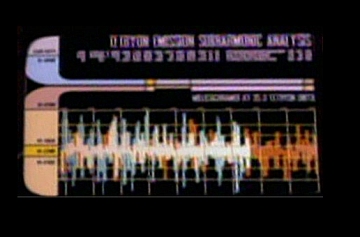
In Star Trek, a tetryon is a subatomic particle that can
only exist naturally in subspace environments. Tetryon radiation is a
bombardment of these particles. Since these particles are a property of
subspace, they become highly energetic and unstable when they are
extruded into normal space, which can occur by both natural and
artificial means. Tetryons have a random momentum, and thus cannot be
tracked by sensors.
Tetryons were first mentioned in TNG: "Schisms".
Solanagen-based lifeforms from a tertiary subspace manifold used a
stream of spatially inverted tetryons to open a spatial rupture between
their native realm and the USS Enterprise-D. This allowed them to
abduct several Enterprise crew members for experimentation. Intense
tetryon fields, such as those surrounding the Hekaras Corridor, pose a
hazard to spacecraft. (TNG: "Force of Nature")
In 2372, tetryon pulse echos were used to navigate the
highly unstable atmosphere of a gas giant. However, course
modifications were required after each pulse in order to avoid
detection. This meant that the random momentum to avoid being tracked
by sensors was invalid when emitted as a pulse. (DS9: "Starship Down").
Later, USS Voyager traveled through a region of heavy tetryon
radiation. Lieutenant Tuvok enhanced the ship's shields to compensate.
(VOY: "Distant Origin"). The atmosphere inside a Borg cube contains
tetryon particles. (VOY: "Infinite Regress")
The energy barrier that isolates the territory of the
Ventu on Ledos has a distinct tetryon signature. The Borg had
previously encountered the technology in Species 312. The barrier left
a distinct tetryon flux on debris from a Voyager shuttlecraft that
crashed into it in 2377. (VOY: "Natural Law").
As teryons are prevalent in subspace, the closest
equivalent to these particles in real Physics are probably fermions -
Petit and Sarrazin pointed out that their theory on 'subspace' only
works for fermions. Fermions are particles of matter which are
characterized by spin in odd half-integer quantum units
(1/2,3/2,5/2...). Fermions were named by Paul Dirac in 1947 after the
Italian physicist Enrico Fermi. They obey the Pauli exclusion principle
and have antisymmetric wavefunctions. All observed elementary particles
are either fermions or bosons. The known elementary fermions are
divided into two groups - quarks and leptons. Quarks make up protons,
neutrons and other baryons, which are composite fermions; they also
comprise mesons, which are composite bosons. Leptons include the
electron and similar, heavier particles (the muon and tauon); they also
include neutrinos.
|
